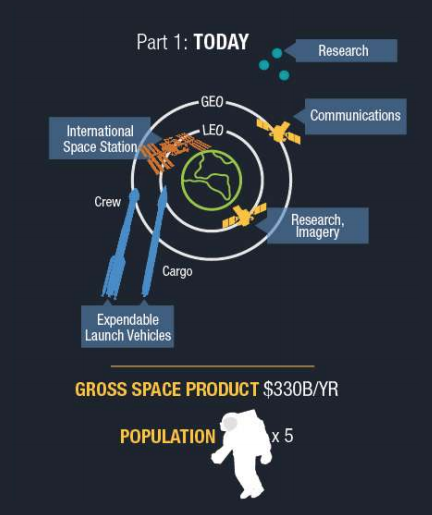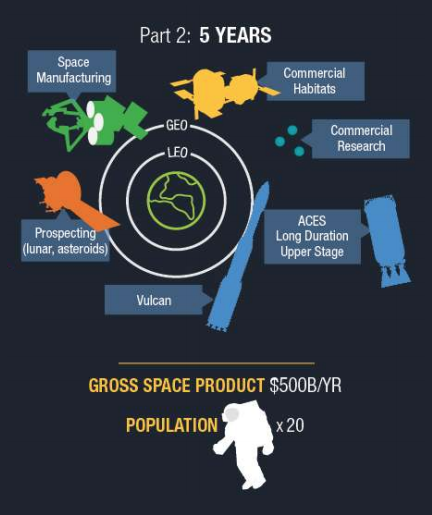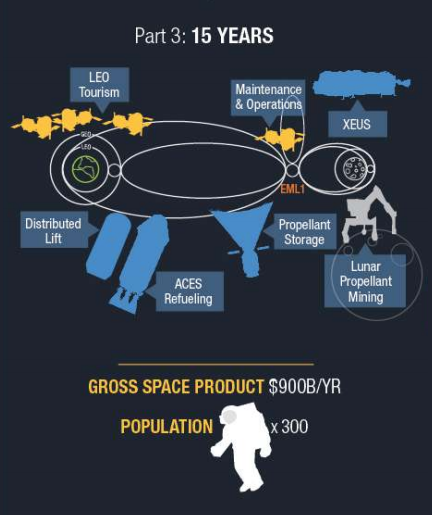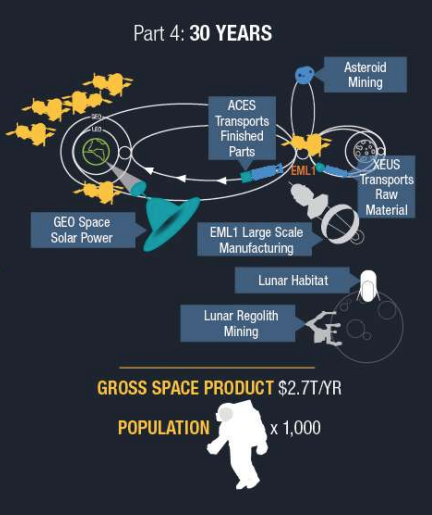
The Waypaver Foundation and The Moon Society


The Waypaver Foundation is a donor funded non-profit with the mission of removing obstacles to human lunar settlement. The Foundation’s website is http://waypaverfoundation.org/. The Moon Society and Waypaver have joined forces to provide the Society direct access to researchers and projects that need resources. The Society can mobilize its members and fundraising infrastructure while the Foundation’s research connections and experts can vette the research that needs to be done and who can do the work. Coordination is simple since the CEO of the Foundation, Michael Mealling, is also the Society’s current President.
The Foundation even has its own version of the Artemis Databook in the form of the Integrated Space Plan (https://integratedspaceanalytics.com/cms/plan). Discussions are underway to move the Index into the Lunarpedia. Future projects include working together on an update to the Moon Society website, targeted economic and financial research, policy statements, and joint funding of lunar surface operations research.
Space Directive 1 and US Space Policy
On December 11, 2017 President Trump signed Space Directive 1 in a signing ceremony at the White House. The Directive made one change to the National Space Policy of 2010 that replaced the paragraph beginning “Set far-reaching exploration milestones” with:
“Lead an innovative and sustainable program of exploration with commercial and international partners to enable human expansion across the solar system and to bring back to Earth new knowledge and opportunities. Beginning with missions beyond low-Earth orbit, the United States will lead the return of humans to the Moon for long-term exploration and utilization, followed by human missions to Mars and other destinations;”.

Here are some highlights of the talking points release prior to the event:
- Instructed the National Aeronautics and Space Administration (NASA) to pursue manned extraterrestrial exploration.
- Space Policy Directive – 1 instructs NASA to return American astronauts to the moon.
- At its inaugural October meeting, the National Space Council unanimously agreed to lead commercial and international partners above and beyond previous U.S. space policy:
- Return United States astronauts to the Moon for long-term exploration and utilization
- By refocusing our space program on feasible goals, President Trump will create incentives for private industry that spur 21st century space capabilities.
- The Moon is of interest to international partners and is within reach of America’s private space industry.
- Under the new Space Policy Directive, the United States will help drive the burgeoning domestic space industry, bring new knowledge from the cosmos, and spur incredible technology.
The Society is a non-partisan organization and as such applauds any effort to return humans to the moon permanently and to develop lunar resources for use on Earth and in space.
Details on program changes and funding priorities will begin to become clearer once budget requests begin to be released in February and March. The text of the Directive can be found here: https://www.whitehouse.gov/presidential-actions/presidential-memorandum-reinvigorating-americas-human-space-exploration-program/
United Launch Alliance’s Cislunar 1000 Vision
In 2016 United Launch Alliance released their plan for 1,000 people living and working in Earth-moon space roughly 30 years from now. Called the “Cislunar 1,000 Vision”, the plan is based on the simple idea that transportation from Low Earth Orbit (LEO) to anything beyond Medium Earth Orbit (MEO) can have significant cost savings if the fuel necessary to transfer the payload from LEO to the desired orbit is delivered to LEO from the Moon (e.g. down the gravity well) rather than from the Earth’s surface up (e.g. up the gravity well).
ULA envisions four major steps:




The interesting development in the past year has been that ULA has publicly acknowledged what many in the industry had only heard as rumors: that the company had signed MOUs for fuel at LEO for the first stage of the plan for around $1 billion. The company felt strongly enough about the plan that it was willing to act as a ‘market maker’ by signing agreements with fuel developers that those developers could use to raise funds.
Regardless of whether ULA’s vision unfolds as they are planning, their economic statement has already affected national space policy and how money is being deployed in the commercial sector. The best summary of ULAs plan can be found in a Youtube video they produced last year:
Moon Village Association Workshop Report
Another development that began in 2016 but saw considerable developments in 2017 was Johann-Dietrich Wörner, the Director General of the European Space Agency, plan for lunar cooperation called the Moon Village. While a difficult concept to pin down, the general idea is that the Moon can handle large numbers of players with different goals who can cooperate in various ways such that the result is more than any one player can afford to do on their own.
Earlier this year ESA and others created an independent organization called the Moon Village Association (MVA) whose mission is to provide a forum for further developing the idea and for cooperation among organizations inside and outside of Europe. The Association has four main working groups: economics & finance, site(s) selection, systems architecture, and association participation mechanisms.
Michael Mealling, President of the Moon Society, attended the first public meeting of the Association at the International Space University in Strasbourg this fall and is a regular participant in the economics and finance working group. It is expected that the MVA will have similar meetings in 2018 in which the Moon Society will participate as an affiliated organization.
Google Lunar XPRIZE Team Update
2017 came and went with no team winning the Google Lunar XPRIZE. The expectation was that the competition would end at the end of 2017 but Google and The XPRIZE Foundation announced that as long as the team landed prior to March 31, 2018 it could still win. The previous cutoff in 2015 was that only those teams that had a verified launch contract prior to the end of 2016 would be allowed to move forward. The current competitors are: SpaceIL (spaceil.com), Moon Express (moonexpress.com), Synergy Moon (synergymoon.org), Team Indus (teamindus.in), and Hakuto (team-hakuto.jp).
As of publication there are only three months remaining for any of the teams to launch. But whether any team actually wins the prize is almost irrelevant at this point. The competition and the progress of the teams has stimulated national policy changes (see Space Directive 1 above), capital access (ispace, the parent company of Hakuto, recently raised a $90M Series A), and changes in laws from various countries around the world. The goal of XPRIZE competitions is to stimulate companies and markets so that they can become sustainable industries. If the current trajectory of lunar development continues the prize can be considered a success regardless of whether anyone wins.
Moon Society, Mars Society, and Mars Foundation Join Together To Form The Marspedia Governing Council
Back in August, James Burk approached our Management Committee with an interesting proposal. Burk is the Mars Society’s current IT Director and was our Vice President & Webmaster back when The Moon Society was founded in 2000. Burk’s proposal was that we begin working with The Mars Society, and another organization called The Mars Foundation, to form an official Governing Council over the Marspedia.org wiki. Marspedia was originally started by The Moon Society back in 2007 along with Lunarpedia.org and some other space and science fiction-related wikis.
We accepted Burk’s proposal and appointed one of our board members, James Gholston, to be our official representative on the new Governing Council. Burk and Gholston worked with Bruce Mackenzie from The Mars Foundation to write official Bylaws for Marspedia, to formalize our working relationship with these other space advocacy groups. At a meeting in October, the Council was formed with former Mars Society Executive Director Susan Holden Martin as Chair, and Burk as Vice Chair. Gholston was joined on the Council by our current Webmaster Rosalie Dieteman and also by Mike Delaney. Several officers from The Mars Society also joined the Council including Lucinda Offer (Executive Director), Carie Fay (Administrative Director), Michael Stoltz (Media & Public Relations), and Nicole Willett (Education Director). The Mars Society also began a major PR push to recruit volunteers and ask for content submissions via Facebook, LinkedIn, and their e-mail Newsletter.
Currently, we have formed Editorial and Technical Subcommittees and we are plugging in volunteers there. Anybody can help grow and manage the wiki, and can request a free account on www.marspedia.org. In 2018, we plan to roll out an atlas of Mars, and add to the stable of high-quality articles on various Mars-related topics. We will also fold in the new learnings and technologies used on Marspedia into the other wikis that the Moon Society maintains, such as Lunarpedia.
President’s Report to Our Members on The State of The Society
(as presented at the Society’s 9th Annual Membership Meeting on August 16, 2017)
The state of the Society is that the Society is not where it should be but it has a plan for improvement and we are entering a time where Lunar development is at least not taking a back seat to other priorities in space. An opportunity is presenting itself and the leadership of the Society is working to seize it.
Membership
As of 08/09/17, Moon Society membership stood at 89 members, down from 136 a year ago, an 34% decrease.
Treasury Report and Project Funding Proposals
The Society has funds available in the amount of $33,000, approximately flat from a year ago.
The Challenge of Projects
There are several great projects that the Society has approved to be done and many that could be done. The limitation on accomplishing these goals is the volunteer manpower to actually do the work. Increasing the participation by and value returned to our membership is our largest goal for the coming year.
Website
Our website is now running on a Drupal 7 platform and is basically stable. The goal of the coming year is to update the design of both the main Moon Society web presence as well as the Lunarpedia. The Web has changed a lot over the years and many potential members use their mobile devices as their primary computing system. The Society must go to where the members are.
Other Web Assets
Our Facebook page and the Lunarpedia project continue to be one of our most popular portals.
Moon Miner’s Manifesto
Moon Miner’s Manifesto completed its 25th year of continuous publication, ten issues a year, with the November 2011 issue, #250. While individual back issues (in electronic pdf file format # 145 forward) remain username/password protected, all the non-time sensitive articles from the first 21 years are republished in the MMM Classics series, freely available to anyone. Peter Kokh, President Emeritus, has retired, but we will resume publishing soon but only electronically.
Collaborations
There is much going on lunar related in the space industry. Most of it is public but some is being done by private companies.
National Space Society
Our collaboration with the NSS is still strong but NSS has picked up the bulk of the effort, especially programming the lunar track at ISDC recently. This should change during the coming year.
The Waypaver Foundation
Our new President, Michael Mealling, is also the CEO of the Waypaver Foundation. Waypaver is a non-profit foundation working to fund specific scientific, political, and economic work necessary to remove any obstacles to lunar settlement. The proposal on the table to both the Moon Society board and the Waypaver board is to create a closer collaboration to solve some of the Society’s volunteer shortfalls. Waypaver also has relationships with the Moon Village effort with ESA, the Lunar Marketplace within the FAA, and other small groups around the world. Waypaver is proposing to help the Society with a site redesign, combining its Lunar Settlement Index with the Lunarpedia, and providing a conduit for sponsored research.
Chapters
Chapters are a primary way to organize members in support of the Society and its Goals. The past two years has not seen much support for chapters from the Society. This should change over the next year as chapters become involved in fundraising for targeted research, lobbying efforts within Congress, and local outreach.
Policy and Positions
During the next few weeks the Society will be developing policies, position papers, and announcements concerning:
- Moon Village – Providing support and volunteers for efforts within ESA and affiliated groups in support of the Moon Village Association.
- NASA Deep Space Gateway – A position paper on the Society’s view of NASA’s Deep Space Gateway and how best to support commercial development of the Moon.
- ULA’s cislunar1000 – A paper on ULA’s efforts and support from the Society on the technology needed to make that effort successful.
Looking Forward
My goal as President is to ‘reboot’ the Moon Society and give it the resources and stature of other space advocacy organizations. 2017 and 2018 are not about ‘rebuilding’ but ‘reinventing’. What isn’t working will be stopped. What is working will be amplified. The Moon Society has some incredible resources and people and it is an incredible time to be focused on Earth’s nearest neighbor.
The Lunar Space Elevator, a Near Term Means to Reduce Cost of Lunar Access
The following is the first installment of a serialized paper, copyright of Charles Frank Radley (2017), reproduced with his permission. Charles is founder of the new Moon Society Florida Outpost. This paper was originally published at the AIAA [American Institute of Aeronautics and Astronautics] Space 2017 Conference proceedings.
Charles F Radley [1]
Leeward Space Foundation, Inc., Palm Bay, Florida, 32907
A Lunar Space Elevator [LSE] can be built today from existing commercial polymers; manufactured, launched and deployed for less than $2B. A prototype weighing 48 tons with 100 kg payload can be launched by 3 Falcon-Heavy’s, and will pay for itself in 53 sample return cycles within one month. It reduces the cost of soft landing on the Moon at least threefold, and sample return cost at least ninefold. Many benefits would arise. A near side LSE can enable valuable science mission, as well as mine valuable resources and ship to market in cislunar space, LEO and Earth’s surface. A far-side LSE can facilitate construction and operation of a super sensitive radio astronomy facility shielded from terrestrial interference by the Moon. The LSE would facilitate substantial acceleration of human expansion beyond LEO.
I. Introduction
The original idea for a Space Elevator was for an elevator from the surface of the Earth up to Geostationary orbit. This idea is attractive since in theory it could greatly reduce the cost of access to space 1,2, however, there are no materials existing or on the horizon which are remotely strong enough to hold their own weight over the distance in the Earth’s gravity field. Theoretically Single-Walled Carbon Nanotubes [SWCNTs] would suffice3, but so far nobody can manufacture them longer than a few centimeters. Furthermore, SWCNTs have only been produced in tiny quantities in laboratories, and there is no prospect of industrial scale production happening in the foreseeable future. However, there is another planetary scale tether concept which is almost as valuable, and can be built with existing industrial materials, and that is a Lunar Space Elevator [LSE].
A LSE is a very long tether, connecting the surface of the Moon to an Earth Moon Lagrange [EML] point, either EML1, between Earth and Moon (nearside), or EML2, behind the Moon as viewed from the Earth (farside). In order for the LSE system to be stationary with respect to the Moon it is necessary that the center of mass of the LSE be located at an EML point. Therefore, the tether must extend further from the lunar surface than the EML point, and be terminated at a counterweight. The Moon orbits the Earth about once per month, so the LSE is not stationary with respect to the Earth, but it is stationary with respect to the Moon.
The LSE dimensions are larger than any structure in space so far attempted. In a design calculated by T. M. Eubanks the total length of a nearside elevator is 278,544 kilometres [154,747 statute miles], and the total length of the farside elevator is 297,308 kilometres [165,171 statute miles] 5.
On average, EML1 is 326,380 km [203,988 statute miles] away from Earth and 58,019 km [36,263 statute miles] away from the Moon. EML2 is 448,914 km [280,573 statute miles] from Earth and 64,515 km [40,323 statute miles] from the Moon. Hence, in the Eubanks design, the distance from the Lagrange point to the counterweight for the EML1 system is 220,525 km [118,484 statute miles] and for the EML2 system is 232,793 km [124,848 statute miles].
These distances are unprecedented in aerospace engineering, and we can reasonably question whether it is even possible to build structures so large. Yet preliminary analysis indicates it is not only possible, it is relatively inexpensive, and can be done with existing commercial materials5. In this paper we will show how the lunar elevator is both feasible and affordable, and indeed profitable. Of course, there will be many technical and engineering challenges, but as far as we know today, there are no obvious showstoppers.
The idea of a lunar elevator is not new, but until recently has been dismissed as fantasy or science fiction. The first known writing, where the concept of a lunar elevator was described by Tsander in 1910, was in the unpublished notes of the German-Latvian-Russian scientist Friedrich Zander. These notes were posthumously published in Moscow in 19776 and noticed by Dr. Eugene Levin, who has since become one of the leading experts on the concept. Levin joined Pearson and his team at Star Technology Inc., where they have jointly studied the LSE concept, notably for NASA Institute of Advanced Concepts in 2005.
II. Available Materials
The first key technical challenge of the LSE, is to find a material which is both light enough and strong enough to support its own weight over that distance in the lunar gravity field, and still be strong enough to carry a payload. Until the late 20th century, such materials did not exist, but since the 1990’s, revolutionary new polymer materials have become commercially available.
The first material which was theoretically capable of supporting a lunar elevator was Kevlar®, but it was only barely strong enough. Fortunately, newer even stronger [by weight] materials have subsequently come on to the market; four in particular are T1000G®, Dyneema®7, Magellan-M5®8 and Zylon®9. Another theoretical material which would be even stronger would be SWCNTs, however they have only been produced in small crystal sizes, about a couple of centimetres in size, suffer from extreme susceptibility to nano-defects10, and are a long way from being commercially viable. Fortunately, the other satisfactory materials are mass-produced in ample quantities and lengths, and we do not need to wait for SWCNTs to begin the construction of LSE. The Magellan M5® material is superior to everything else currently available; however, supplies are very limited on the commercial market. The reasons for this are not entirely clear, but according to anecdotal information, it appears to be twofold. Firstly, M5® is difficult to manufacture, partly because of its extraordinary strength, it tends to destroy the tooling. Secondly, it is in high demand by the US Government, especially for bulletproof vests, and the US Government buys up nearly all of the available production to date. The three other materials, T1000G, Dyneema® and Zylon®, are available in large quantity, and are currently the best candidates for LSE construction, at least until M5® eventually becomes available in greater quantity, or until an even better material become widely available.
III. Throughput and Return on Investment
The term “Lunar Elevator” is something of a misnomer when applied to the lunar skylift system. That is because, although the system conceptually bears some similarity to a terrestrial elevator, there is a fundamental difference. That is, a terrestrial elevator typically has a single car, travelling up and down a single shaft. We will show that the optimal configuration for a lunar elevator is significantly different. Specifically, a lunar elevator can and should carry multiple cars to maximize throughput within the strength capabilities of the tether. We will show below that a single LSE can ideally carry six cars simultaneously on the section of tether between the EML and the lunar surface. Furthermore, during a two week period, about 80 cars could be lifted from the surface to EML, resulting in an eighty times increase in payload mass throughput.
A key figure of merit is the speed with which the climber travels up and down the tether. From a business standpoint, we wish to maximize revenue, which means maximizing the payload throughput of the system. Throughput can be expressed in terms of mass of payload times speed of climber times number of climbers in a given time period.
The Delta Vee required for a rocket to ascend from lunar surface to EML-1 is 2.7 km s1. Goff[2] showed that the typical payload mass fraction for such a rocket is 34%, ~ 1/3. A rocket which puts the 49 tonnes LSE at EML-1 would otherwise be capable of depositing 16 tonnes on to the lunar surface. So for LSE payload of 0.1 tonnes, this is equivalent to 16/0.1 ¼ 160 payload landing cycles, which is the number of cycles to recoup the LSE launch cost. For sample return, another factor of three applies, so ~ 53 sample return cycles would recoup the launch cost.
The principal benefit of the LSE is that it reduces the cost of sample return by at least nine times, considering primarily the cost of launch, but without considering the capital cost of manufacture, since that has not yet been studied in detail. In any case, we believe the launch cost will be the dominant cost of the system.
In terms of launch cost, we need to make 53 sample return cycles to realize a profit, then we need to complete those 53 cycles as quickly as possible. The 2008 Technion University student team estimated that a velocity of 700 metres per second is feasible, hence the journey from the surface of the Moon to the Lagrange station would take about seven days[3].
Interestingly, it is feasible to have multiple climbers on the tether, without significantly reducing the payload, and this would greatly increase system throughput. At a velocity of 700 metres per second, it is feasible to have 80 climbers along the tether [see Table-1], and that means that 50 payload cycles can be completed within a month. So the LSE can pay back its launch cost in less than a month, giving a total throughput of 8 tons per month in each direction, or ~100 tons per year. The incremental operational cost per payload cycle is negligible compared to the corresponding cost of using chemical propulsion; hence it will rapidly reduce the total cost by orders of magnitude.
Of course if the climber could move even faster, then the revenue stream per year would be even greater, which would be very pleasing to investors. Hence, there is a commercial incentive to maximize the climber speed. It might be possible to increase the climber speed even more than 700 m/s This involves various technical challenges, which have been studied to a first approximation, and will be discussed in this paper.
[To be continued]
[1] Systems Engineer, Associate Fellow AIAA
[2] Goff, The Slings and Arrows of Outrageous Lunar Transportation Schemes: Part 1 Gear Ratios, Selenian Boondocks, 2013. http://selenianboondocks.com/2013/12/the-slings-and-arrows-of-outrageous-lunar-transportationschemes-part-1-gear-ratios/.
[3] Qedar R. , Grinfeld N. , Bezrodny G. , Reuven O. , Tatievsky A. , Kogan A,. Jacob’s Ladder – Lunar Space Elevator http://lunarjacobsladder.webs.com/
Note: A full set of references will be provided at the end of the final installment in a future issue of Moon Miners Manifesto.
References
1 Swan, P. A, Raitt, D. I., Swan, C.W., Penny, R.E., Knapman, J.M., Space Elevators: An Assessment of the Technological Feasibility and the Way Forward, Virginia Edition Publishing Co, Science Deck, 2013. ISBN-13: 978-2917761311.
2 Swan, P.A, Opening up earth-moon enterprise with a space elevator, New Space 3 (2015) 213e217, http://dx.doi.org/10.1089/space.2015.0025.
3 Edwards, B. C, Design and Deployment of a Space Elevator, Acta Astronautica, 47, 10, Nov 2000, 735-744
4 Pearson, J, Levin, E., Oldson, J, Wykes, H, Lunar Space Elevators for Cislunar Space Development, NASA Institute of Advanced Concepts, Phase I Final Technical Report, Star Technology and Research, Inc, 2005.
5 Eubanks, T. M., Radley, C. F., Scientific return of a lunar elevator, Space Policy 37 (2016) 97
6 Tsander, F. A., (1977). Selected Papers (in Russian). Riga: Zinātne.
7 Stein, H.L, Ultrahigh molecular weight polyethylenes (uhmwpe), in: Engineered Materials Handbook: Engineering Plastics, Vol. 2ASM International, 1998, pp. 167e171.
8 Cunniff, P, Auerbach M. A., Sikkema D. J.,Vetter, E, High Performance “M5” Fiber for Ballitstics / Structural Composites, 2002: 23’th Army Science Conference, Orlando, FL
9 Wolfe, J.F., Polybenzothiazoles and Oxazoles, in: Encyclopedia of Polymer Science and Engineering, Vol. 11John Wiley and Sons, 1988, p. 601.
10 Liyan, Z, Jinlan, W, Feng, D, The Great Reduction of a Carbon Nanotube’s Mechanical Performance by a Few Topological Defects, ACS Nano, 2016, 10 (6), pp 6410–6415
Update on the Manifesto and Its Future
This publication was in continuous publication from 1986 until the beginning of 2017. It was written and published by Peter Kokh who retired from publication of the Manifesto at the end of 2016. Issue #301 was his last. During that time it served as the monthly newsletter for the SE Wisconsin Chapter of the National Space Society, the Milwaukee Outpost of the Moon Society, and eventually the Moon Society itself.
The reins have been handed over to the Moon Society leadership, and we apologize for the hiatus. With this issue, we are transitioning from a physical paper format to one published as a PDF and on the Moon Society website. Existing subscribers will receive a PDF by email.
As part of the update the Society will be making all previous versions available publicly and, where possible, will be converting PDF versions into web accessible versions.

